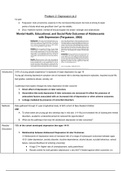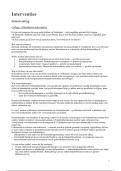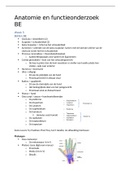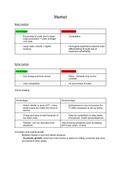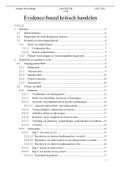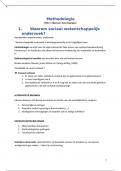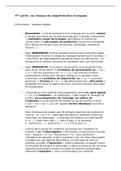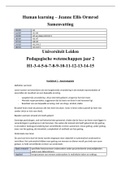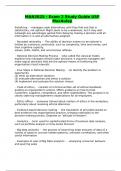Problem 2: Depression pt.2
1st part
● Fergusson: look at outcome, essence in the conclusion/discussion but look at strong & weak
points of study what was good/bad- don’t go into details.
● Zhou- Kathrine harmer: mental elf should explain the article- strength and weaknesses
Mental Health, Educational, and Social Role Outcomes of Adolescents
with Depression (Fergusson, 2002)
Introduction 2-8% of young people experience 1st episode of major depression by age 16
Young ppl showing depressive symptom are at increased risk to develop depressive episodes, impaired social life,
bad grades, substance abuse, anxiety, etc
3 pathways that explain linkage btw early depression & later outcome
1. Direct effect of depression on later outcomes
2. Association btw early depression & later outcomes are noncausal & reflect the presence of
antecedent factors associated with an increased risk of depression or other adverse outcomes.
3. Linkage mediated by presence of comorbid disorders
Methods Data gathered through 21-year longitudinal study of birth cohort of New Zealand children
AIM:
A. To what extent are young ppl who develop dep in mid ado (14-16y) at increased risk of subsequent mental
disorders, academic underachievement & reduced life opportunities?
B. What are the pathways that may link adolescent depression to later outcomes?
Results/ 13% of the cohort developed depression btw ages 14-16
Discussion
1. Relationship between Adolescent Depression & Later Outcomes
⇒ Adolescents w/ depression were at increased risk of a range of subsequent outcomes between ages
16-21 (later depression, anxiety disorder, nicotine dependence, alcohol abuse, suicidal behaviour, school
failure, reduced likelihood of entering university)
● At age 21⇒ Higher rate of unemployment, early parenthood
● Results similar for both genders (depression x sex) BUT if tested against other ouctomes (i.e.
, school→ then sig. gender difference)
2. Social, Familial & Individual Factors Associated w/ Depression in Early Adolescents
⇒ Slight trend for young dep to be reared by mom w/ educational underachievement (also true for non-dep)
● Young depressed more likely to be exposed to sexual abuse & parental change in childhood
● Lower IQ scores at age 9
● Tendencies for neuroticism
● Higher rates of deviant peer involvement in adolescence
● Higher rates of comorbid anxiety disorders, conduct disorders and alcohol abuse & cigarettes
3. Relationship btw Depression in Adolescence & Later Outcomes, Adjusted for Confounding Factors
Suggest 2 conclusion:
(a) Evidence of a clear & specific continuity for adolescent depression to later depression &
anxiety (even after controlling for confounding factors and comorbid disorders)
(b) The associations btw adolescent depression & other outcomes, incl. nicotine, alcohol abuse/
dependence, suicide attempts, educational underachievement, unemployment & early parenthood
were explained by confounding factors (parental change, childhood sexual abuse, IQ,
neuroticism, etc.
→ So doesn't actually measure direct effects of depression on later adjustment BUT all the other
background factors (personality traits, social background, etc..)
2 major pathways linking dep to later-outcomes
1. There was a direct linkage btw early depression & increased risk of later MDD or anxiety disorders.
2. The associations btw early depression & other outcomes were explained by the presence of confounding
social, familial & id factors.
LIMITATIONS
(1) Specific New Zealand cohort study
(2) Assessment of depression relies on retrospective self-reports
(3) Since self-report- not sure whether symptoms would actually even meet DSM-V criteria
Name 2 diff ways in which a diagnosis of dep at a young age can produce unfavourable results?
● Increased risk of depression, anxiety, nicotine addiction, drug addiction, educational
underachievement, unemployment & early parenthood.
● Direct pathway: “there’s a direct link b/w early depression and later depression/anxiety”. Ado
have depression= adult depression
● Indirect pathway: Indirect link b/w diagnosis and life outcomes (which are due to common 3rd
factor influences: social, familiar or individual factors)” → Lead to depression in the future
● Confounding variable: sexual abuse
, ● Diagnosis of depression early: increases risk of other factors
Name and discuss the used approach and try to name the multiple strengths and limitations of
the study of Ferguson.
● Used approach: Longitudinal study w/ mid-adolescent participants
Limitations: Sample is only from New Zealand + self-report + retrospective (prone to bias) + overcontrol
for confounding variables. They used DSM-3 which is outdated.
Strengths: longitudinal study, first study to look at other variables simultaneously. The model was very
detailed & plentiful variables in the data (makes the statistical analysis stronger) (but this might not be
too good because it confuses the regression).
Comparative efficacy & acceptability of antidepressants,
psychotherapies, & their combination for acute treatment of children &
adolescents with depressive disorder: a systematic review & network
meta-analysis (Zhou et al., 2020)
Introduction Course of MDD is often characterized by heterogeneous symptoms in child & adolescents, protracted episodes,
frequent recurrence and comorbid psychiatric disorders.
● Young patients with dep have more serious impairments in social & educational functioning & have an
increased risk of smoking, substance misuse, obesity, & suicide compared with adults with dep.
● Depression is the 2nd or 3rd leading cause of death in adolescence.
⇒ Combination of antidepressant & psychological interventions is more beneficial than antidepressants alone=
remains unclear.
Aim= synthesise all the available evidence on commonly used antidepressants, psychotherapies, & their
combinations for the acute treatment of depressive disorder in children and adolescents.
, Methods Systematic review & network meta-analysis
Outcomes
1. Primary: efficacy and acceptability
2. Secondary: suicidality
Results 390 articles based on 71 RCTs, 9510 children & adolescents w/ depressive disorders
● The age range was from 3 years to 20 years
● 57.2% of the sample population were female.
● 57.7% North America, 16.9% in Europe, 7.0% in Asia, 2.8% in Australia, and 1.4% in South America.
Discussion Main Findings
1. Only fluoxetine + CBT & fluoxetine alone were significantly more efficacious than pill placebo..
2. Interpersonal psychotherapy was more efficacious than all psychological controls, but with very low
confidence of evidence.
3. Fluoxetine + CBT was associated with a greater reduction in depressive symptoms than either CBT or
psychodynamic psychotherapy, with very low confidence of evidence.
4. Nortriptyline was worse than most active interventions; the interpretation of this result was limited by
the inconsistent loop of nortriptyline vs fluoxetine vs pill placebo.
5. These summary ES were mostly medium-large w/ some uncertainty (small n° of patients & wide intervals).
⇒ Statistical indications of clinical superiority in this study should be interpreted cautiously.
Why are antidepressants & psychological interventions in adults more efficacious than pill placebo/psychological
control conditions?
1. Neurodevelopmental mechanisms (changes in hormones and hormonal receptors in ado) could
exacerbate emotional responses to negative social stimuli by dysregulation of the HPA axis.
2. The smaller number of trials & smaller sample sizes for young patients with depression decreases
statistical power for each comparison.
3. Different design methods btw adult & paediatric trials: could lead to higher placebo response rate in C&A
than adults based on clinician ratings, hindering the detection of pos results for dep in children & ados.
LIMITATIONS
- Quality of most comparisons was low or very low. Many trials: no adequate info on allocation concealment =
Difficult to use a double-blind design for patients in trials which would affect the transitivity of the whole
network & restricts the interpretation of these results. Sensitivity analysis: findings of the primary analysis
did not differ a lot.
- Global/local inconsistencies in efficacy outcomes, few in acceptability outcomes. Although the meta-
regression analyses of modifiers didn’t affect the outcomes, some comparisons had relatively low or high
values in the transitivity assessment; Thus= downgraded the confidence of these comparisons.
- This review was restricted to trials involving childs & ados w/ depressive disorder.
- The findings are limited by the potential bias from selective reporting.
1st part
● Fergusson: look at outcome, essence in the conclusion/discussion but look at strong & weak
points of study what was good/bad- don’t go into details.
● Zhou- Kathrine harmer: mental elf should explain the article- strength and weaknesses
Mental Health, Educational, and Social Role Outcomes of Adolescents
with Depression (Fergusson, 2002)
Introduction 2-8% of young people experience 1st episode of major depression by age 16
Young ppl showing depressive symptom are at increased risk to develop depressive episodes, impaired social life,
bad grades, substance abuse, anxiety, etc
3 pathways that explain linkage btw early depression & later outcome
1. Direct effect of depression on later outcomes
2. Association btw early depression & later outcomes are noncausal & reflect the presence of
antecedent factors associated with an increased risk of depression or other adverse outcomes.
3. Linkage mediated by presence of comorbid disorders
Methods Data gathered through 21-year longitudinal study of birth cohort of New Zealand children
AIM:
A. To what extent are young ppl who develop dep in mid ado (14-16y) at increased risk of subsequent mental
disorders, academic underachievement & reduced life opportunities?
B. What are the pathways that may link adolescent depression to later outcomes?
Results/ 13% of the cohort developed depression btw ages 14-16
Discussion
1. Relationship between Adolescent Depression & Later Outcomes
⇒ Adolescents w/ depression were at increased risk of a range of subsequent outcomes between ages
16-21 (later depression, anxiety disorder, nicotine dependence, alcohol abuse, suicidal behaviour, school
failure, reduced likelihood of entering university)
● At age 21⇒ Higher rate of unemployment, early parenthood
● Results similar for both genders (depression x sex) BUT if tested against other ouctomes (i.e.
, school→ then sig. gender difference)
2. Social, Familial & Individual Factors Associated w/ Depression in Early Adolescents
⇒ Slight trend for young dep to be reared by mom w/ educational underachievement (also true for non-dep)
● Young depressed more likely to be exposed to sexual abuse & parental change in childhood
● Lower IQ scores at age 9
● Tendencies for neuroticism
● Higher rates of deviant peer involvement in adolescence
● Higher rates of comorbid anxiety disorders, conduct disorders and alcohol abuse & cigarettes
3. Relationship btw Depression in Adolescence & Later Outcomes, Adjusted for Confounding Factors
Suggest 2 conclusion:
(a) Evidence of a clear & specific continuity for adolescent depression to later depression &
anxiety (even after controlling for confounding factors and comorbid disorders)
(b) The associations btw adolescent depression & other outcomes, incl. nicotine, alcohol abuse/
dependence, suicide attempts, educational underachievement, unemployment & early parenthood
were explained by confounding factors (parental change, childhood sexual abuse, IQ,
neuroticism, etc.
→ So doesn't actually measure direct effects of depression on later adjustment BUT all the other
background factors (personality traits, social background, etc..)
2 major pathways linking dep to later-outcomes
1. There was a direct linkage btw early depression & increased risk of later MDD or anxiety disorders.
2. The associations btw early depression & other outcomes were explained by the presence of confounding
social, familial & id factors.
LIMITATIONS
(1) Specific New Zealand cohort study
(2) Assessment of depression relies on retrospective self-reports
(3) Since self-report- not sure whether symptoms would actually even meet DSM-V criteria
Name 2 diff ways in which a diagnosis of dep at a young age can produce unfavourable results?
● Increased risk of depression, anxiety, nicotine addiction, drug addiction, educational
underachievement, unemployment & early parenthood.
● Direct pathway: “there’s a direct link b/w early depression and later depression/anxiety”. Ado
have depression= adult depression
● Indirect pathway: Indirect link b/w diagnosis and life outcomes (which are due to common 3rd
factor influences: social, familiar or individual factors)” → Lead to depression in the future
● Confounding variable: sexual abuse
, ● Diagnosis of depression early: increases risk of other factors
Name and discuss the used approach and try to name the multiple strengths and limitations of
the study of Ferguson.
● Used approach: Longitudinal study w/ mid-adolescent participants
Limitations: Sample is only from New Zealand + self-report + retrospective (prone to bias) + overcontrol
for confounding variables. They used DSM-3 which is outdated.
Strengths: longitudinal study, first study to look at other variables simultaneously. The model was very
detailed & plentiful variables in the data (makes the statistical analysis stronger) (but this might not be
too good because it confuses the regression).
Comparative efficacy & acceptability of antidepressants,
psychotherapies, & their combination for acute treatment of children &
adolescents with depressive disorder: a systematic review & network
meta-analysis (Zhou et al., 2020)
Introduction Course of MDD is often characterized by heterogeneous symptoms in child & adolescents, protracted episodes,
frequent recurrence and comorbid psychiatric disorders.
● Young patients with dep have more serious impairments in social & educational functioning & have an
increased risk of smoking, substance misuse, obesity, & suicide compared with adults with dep.
● Depression is the 2nd or 3rd leading cause of death in adolescence.
⇒ Combination of antidepressant & psychological interventions is more beneficial than antidepressants alone=
remains unclear.
Aim= synthesise all the available evidence on commonly used antidepressants, psychotherapies, & their
combinations for the acute treatment of depressive disorder in children and adolescents.
, Methods Systematic review & network meta-analysis
Outcomes
1. Primary: efficacy and acceptability
2. Secondary: suicidality
Results 390 articles based on 71 RCTs, 9510 children & adolescents w/ depressive disorders
● The age range was from 3 years to 20 years
● 57.2% of the sample population were female.
● 57.7% North America, 16.9% in Europe, 7.0% in Asia, 2.8% in Australia, and 1.4% in South America.
Discussion Main Findings
1. Only fluoxetine + CBT & fluoxetine alone were significantly more efficacious than pill placebo..
2. Interpersonal psychotherapy was more efficacious than all psychological controls, but with very low
confidence of evidence.
3. Fluoxetine + CBT was associated with a greater reduction in depressive symptoms than either CBT or
psychodynamic psychotherapy, with very low confidence of evidence.
4. Nortriptyline was worse than most active interventions; the interpretation of this result was limited by
the inconsistent loop of nortriptyline vs fluoxetine vs pill placebo.
5. These summary ES were mostly medium-large w/ some uncertainty (small n° of patients & wide intervals).
⇒ Statistical indications of clinical superiority in this study should be interpreted cautiously.
Why are antidepressants & psychological interventions in adults more efficacious than pill placebo/psychological
control conditions?
1. Neurodevelopmental mechanisms (changes in hormones and hormonal receptors in ado) could
exacerbate emotional responses to negative social stimuli by dysregulation of the HPA axis.
2. The smaller number of trials & smaller sample sizes for young patients with depression decreases
statistical power for each comparison.
3. Different design methods btw adult & paediatric trials: could lead to higher placebo response rate in C&A
than adults based on clinician ratings, hindering the detection of pos results for dep in children & ados.
LIMITATIONS
- Quality of most comparisons was low or very low. Many trials: no adequate info on allocation concealment =
Difficult to use a double-blind design for patients in trials which would affect the transitivity of the whole
network & restricts the interpretation of these results. Sensitivity analysis: findings of the primary analysis
did not differ a lot.
- Global/local inconsistencies in efficacy outcomes, few in acceptability outcomes. Although the meta-
regression analyses of modifiers didn’t affect the outcomes, some comparisons had relatively low or high
values in the transitivity assessment; Thus= downgraded the confidence of these comparisons.
- This review was restricted to trials involving childs & ados w/ depressive disorder.
- The findings are limited by the potential bias from selective reporting.

